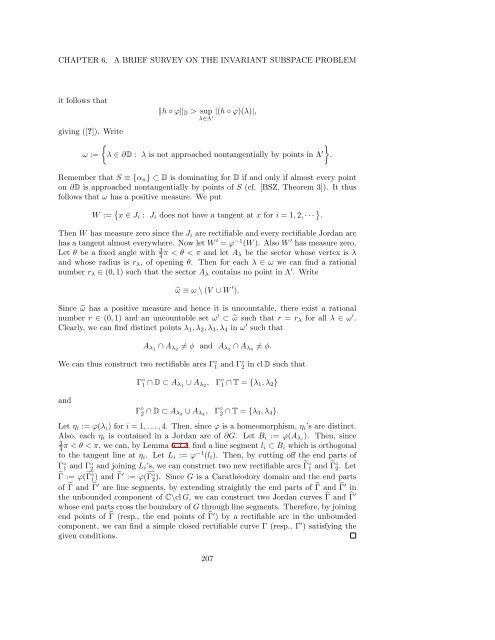Woo Young Lee Lecture Notes on Operator Theory
Woo Young Lee Lecture Notes on Operator Theory
Woo Young Lee Lecture Notes on Operator Theory
Create successful ePaper yourself
Turn your PDF publications into a flip-book with our unique Google optimized e-Paper software.
CHAPTER 6.<br />
A BRIEF SURVEY ON THE INVARIANT SUBSPACE PROBLEM<br />
it follows that<br />
giving ([]). Write<br />
ω :=<br />
∥h ◦ φ∥ D > sup<br />
λ∈Λ ′ |(h ◦ φ)(λ)|,<br />
{λ ∈ ∂D : λ is not approached n<strong>on</strong>tangentially by points in Λ ′ }<br />
.<br />
Remember that S ≡ {α n } ⊂ D is dominating for D if and <strong>on</strong>ly if almost every point<br />
<strong>on</strong> ∂D is approached n<strong>on</strong>tangentially by points of S (cf. [BSZ, Theorem 3]). It thus<br />
follows that ω has a positive measure. We put<br />
W := { x ∈ J i : J i does not have a tangent at x for i = 1, 2, · · · }.<br />
Then W has measure zero since the J i are rectifiable and every rectifiable Jordan arc<br />
has a tangent almost everywhere. Now let W ′ = φ −1 (W ). Also W ′ has measure zero.<br />
Let θ be a fixed angle with 3 4 π < θ < π and let A λ be the sector whose vertex is λ<br />
and whose radius is r λ , of opening θ. Then for each λ ∈ ω we can find a rati<strong>on</strong>al<br />
number r λ ∈ (0, 1) such that the sector A λ c<strong>on</strong>tains no point in Λ ′ . Write<br />
˜ω ≡ ω \ (V ∪ W ′ ).<br />
Since ˜ω has a positive measure and hence it is uncountable, there exist a rati<strong>on</strong>al<br />
number r ∈ (0, 1) and an uncountable set ω ′ ⊂ ˜ω such that r = r λ for all λ ∈ ω ′ .<br />
Clearly, we can find distinct points λ 1 , λ 2 , λ 3 , λ 4 in ω ′ such that<br />
A λ1 ∩ A λ2 ≠ ϕ and A λ3 ∩ A λ4 ≠ ϕ.<br />
We can thus c<strong>on</strong>struct two rectifiable arcs Γ ◦ 1 and Γ ◦ 2 in cl D such that<br />
and<br />
Γ ◦ 1 ∩ D ⊂ A λ1 ∪ A λ2 , Γ ◦ 1 ∩ T = {λ 1 , λ 2 }<br />
Γ ◦ 2 ∩ D ⊂ A λ3 ∪ A λ4 , Γ ◦ 2 ∩ T = {λ 3 , λ 4 }.<br />
Let η i := φ(λ i ) for i = 1, . . . , 4. Then, since φ is a homeomorphism, η i ’s are distinct.<br />
Also, each η i is c<strong>on</strong>tained in a Jordan arc of ∂G. Let B i := φ(A λi ). Then, since<br />
3<br />
4 π < θ < π, we can, by Lemma 6.4.3, find a line segment l i ⊂ B i which is orthog<strong>on</strong>al<br />
to the tangent line at η i . Let L i := φ −1 (l i ). Then, by cutting off the end parts of<br />
Γ ◦ 1 and Γ ◦ 2 and joining L i ’s, we can c<strong>on</strong>struct two new rectifiable arcs ˜Γ ◦ 1 and ˜Γ ◦ 2. Let<br />
˜Γ := φ(˜Γ ◦ 1 ) and ˜Γ ′ := φ(˜Γ ◦ 2 ). Since G is a Carathéodory domain and the end parts<br />
of ˜Γ and ˜Γ ′ are line segments, by extending straightly the end parts of ˜Γ and ˜Γ ′ in<br />
the unbounded comp<strong>on</strong>ent of C\cl G, we can c<strong>on</strong>struct two Jordan curves ̂Γ and ̂Γ ′<br />
whose end parts cross the boundary of G through line segments. Therefore, by joining<br />
end points of ̂Γ (resp., the end points of ̂Γ ′ ) by a rectifiable arc in the unbounded<br />
comp<strong>on</strong>ent, we can find a simple closed rectifiable curve Γ (resp., Γ ′ ) satisfying the<br />
given c<strong>on</strong>diti<strong>on</strong>s.<br />
207













